Special Report
The Poorest Countries in the World
Published:
Last Updated:
The distribution of wealth across the globe is anything but even. North America is home to just 4.9% of the world’s population — and 26.5% of its wealth. Meanwhile, South Asia is home to 23.7% of the global population but owns just 3.6% of global wealth.
While gross domestic product provides an accurate picture of the size of a nation’s economy, gross national income, or GNI, is a more precise measure of citizens’ financial well-being, especially when considering GNI per capita. GNI includes GDP as well as the net income of the country’s residents obtained outside the country’s borders. In the United States, the annual GNI per capita of $53,245 is at least 21 times the GNI per capita in each of the world’s 25 poorest countries. In the Democratic Republic of the Congo, the poorest country in the world, GNI per capita is only $680 a year.
[in-text-ad]
Economic development on a national scale often follows a similar pattern. Poor, developing countries are often largely rural and heavily dependent on agriculture, which is often comprised primarily of subsistence farming. Meanwhile, wealthier nations tend to have larger urban populations and a diverse industrial composition.
Click here to see the poorest countries in the world.
Click here to see the richest countries in the world.
A series of complex factors tend to hold back many poor economies. While many of these factors are intangible, the poorest nations in the world share many identifiable common traits.
From former French colonies in Sub-Saharan Africa to former Soviet nations in Central Asia, the vast majority of the world’s poorest countries have only recently gained independence from a larger power. Political turmoil, violence, and civil war are all detrimental to economic growth and are often seemingly inevitable in newly autonomous states.
For example, Tajikistan gained its independence with the collapse of the Soviet Union in 1991. Almost immediately afterwards, the country descended into a five-year civil war. Most notably perhaps, nearly every African country on this list gained independence from European powers in the latter half of the last century. Many, including Mali, the Democratic Republic of the Congo, and South Sudan are either currently embroiled in civil war or have been in the last decade.
An educated populace and reliable infrastructure are preconditions for economic prosperity. Not surprisingly, they are often conspicuously lacking in the world’s poorest countries. In 17 of the 25 poorest countries, more than a third of the adult population is illiterate. Further stymieing any potential economic growth, less than half the population has access to electricity in 21 of the 25 poorest countries.
With severely limited financial resources, many poor countries also often lack an adequate number of doctors and modern health care systems. Partially as a result, life expectancy is far lower than it is in wealthier nations. In all of the 25 poorest countries, average life expectancy never exceeds 70 years. In the Central African nation of Chad, life expectancy at birth is only 51.6 years. U.S. life expectancy, in contrast, is 78.9 years.
Notably, 23 of the 25 poorest countries are African. In addition to all of the aforementioned drags, African nations face a host of unique hurdles to economic development. Many of the poorest countries located in West Africa have suffered from a decline in tourism following the 2014 Ebola outbreak. In addition, much of the continent is subject to severe drought and flooding, which can have crippling effects on the predominantly agricultural economies. Most notably perhaps is the toll HIV/AIDS is taking on the continent. An estimated 25.6 million people in 2015 live HIV in Sub-Saharan Africa.
To identify the world’s poorest countries, 24/7 Wall St. reviewed GNI data from the World Bank. We ranked the 25 poorest countries based on GNI per capita and supplemented our analysis with GDP and GDP growth rates from the International Monetary Fund, as well as poverty and unemployment rates, life expectancy, literacy, Gini coefficients, educational enrollment, agricultural employment, export and import figures from the World Bank, and additional trade data from MIT’s Observatory of Economic Complexity for 2014. In our analysis, we also included Transparency International’s Corruption Perceptions Index score, which ranks countries based on perceived corruption.
These are the 25 poorest countries.
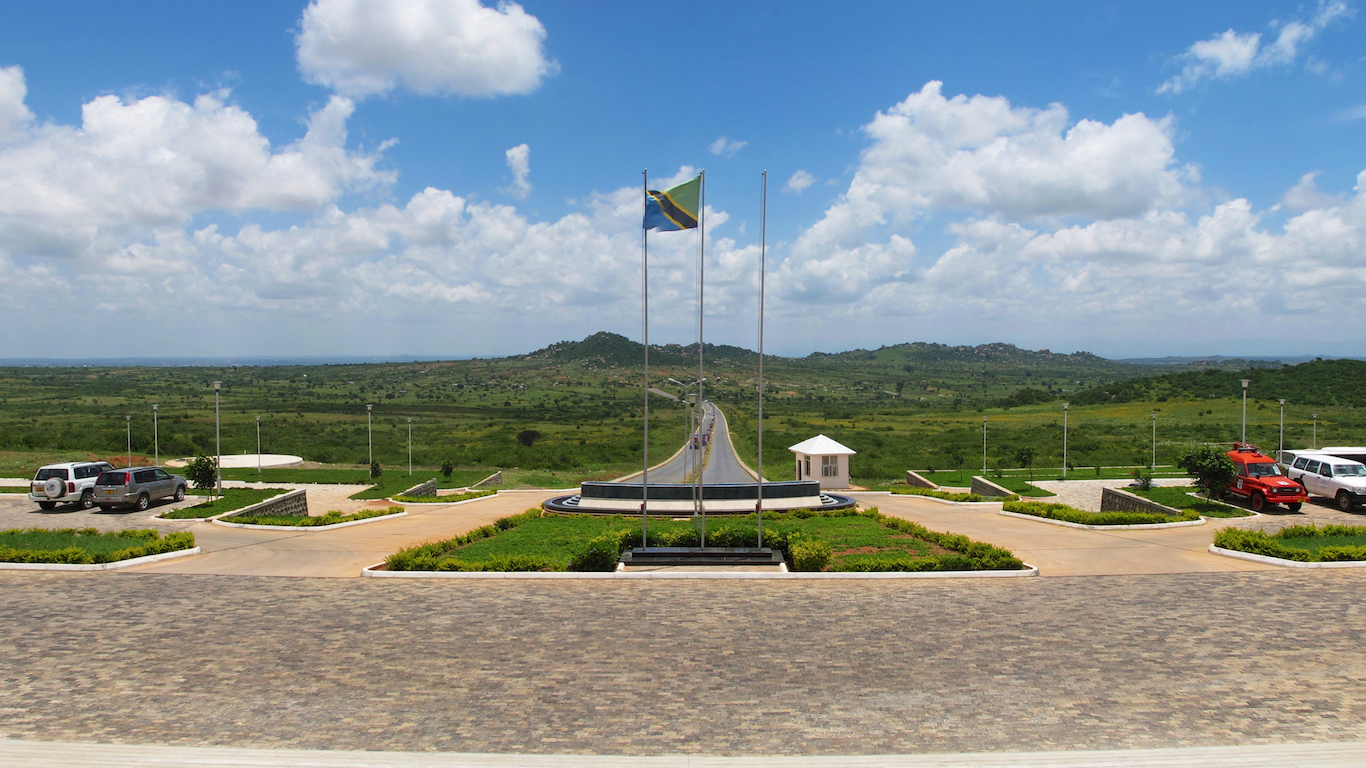
25. Tanzania
> GNI per capita: $2,466.90
> 2015 GDP: $138.73 billion
> Population: 53,470,420
> Life expectancy: 64.9 years at birth
With 53 million residents, the East African nation of Tanzania is one of the most populous on the continent. Unlike many other African economies often decimated by war, the country has recently been relatively free of conflict. Tanzania is nevertheless one of the poorest countries, with a per capita GNI of less than $2,500.
[in-text-ad]
Like many extremely impoverished nations, there are relatively few working-age adults compared to children and senior citizens, who are typically dependant on these workers. In the United States, there are about two working-age adults for every American either under 15 or over 65. In Tanzania, the ratio is close to one for one.
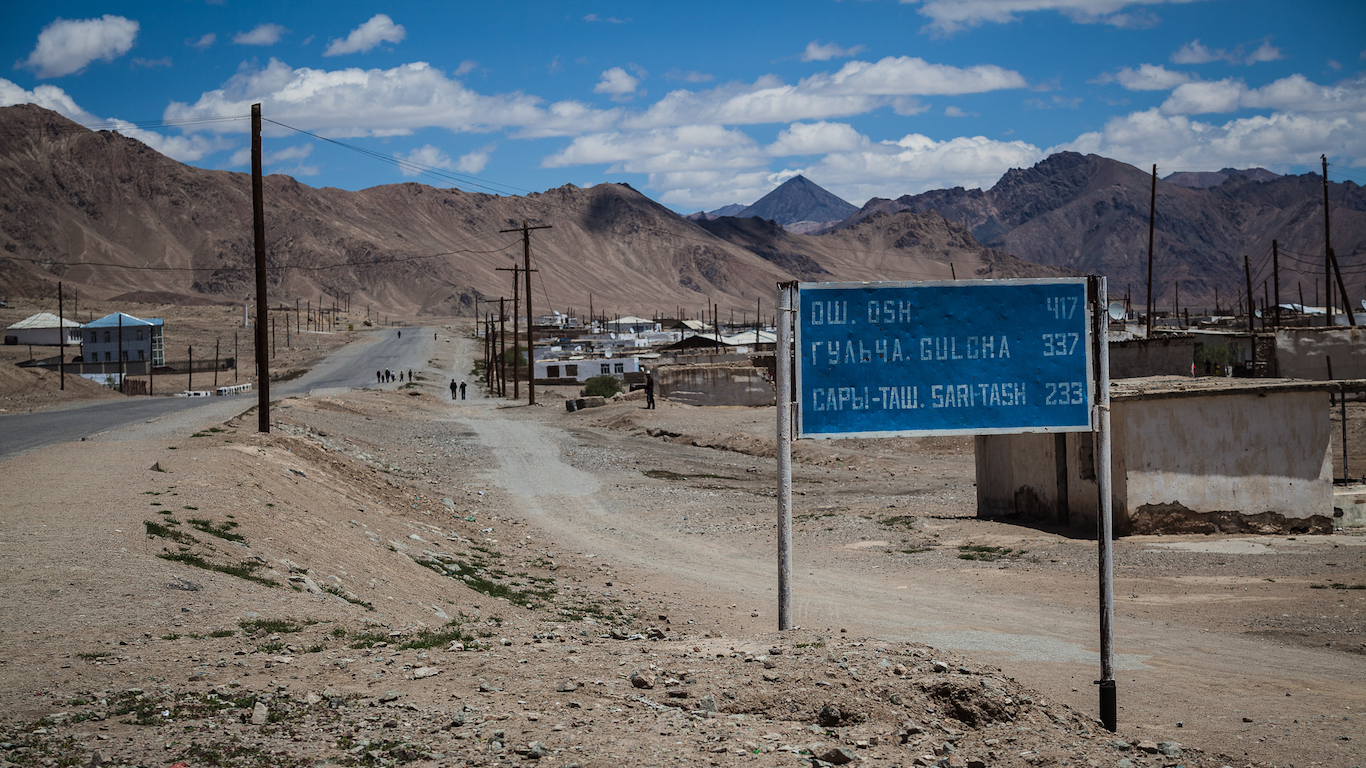
24. Tajikistan
> GNI per capita: $2,445.74
> 2015 GDP: $24.03 billion
> Population: 8,481,855
> Life expectancy: 69.6 years at birth
Tajikistan is a landlocked country on Afghanistan’s northern border, and the poorest of all former members of the Soviet Union. Like many other countries with extremely low per capita income, economic development in Tajikistan has been stymied by conflict. The country descended into civil war in 1992, shortly after gaining independence from the Soviet Union in 1991. The violence lasted until 1997 and claimed an estimated 50,000 lives.
While Tajikistan certainly exhibits many features common of poor nations, in some ways, it is an outlier. Nearly everyone in the country has adequate access to electricity and nearly all adults are literate. Education and basic amenities can help foster economic growth, and Tajikistan’s GDP expanded by 6.0% in 2015, more than the vast majority of other countries.

23. Nepal
> GNI per capita: $2,288.24
> 2015 GDP: $70.20 billion
> Population: 28,513,700
> Life expectancy: 69.6 years at birth
Nepal, the Himalayan nation that forms part of the border between China and India, is home to eight of the world’s 10 tallest mountains. The country was relatively isolated from the rest of the world until the 1950s. In the late 1990s, a civil war broke in Nepal that left thousands dead. More recently, a massive 7.8 magnitude earthquake in 2015 left nearly 9,000 people dead and put further economic strain on one of the world’s poorest nations.
Many poorer countries need to rely heavily on certain industries like mining or agriculture. In the United States, agriculture accounts for just 1.3% of GDP. In Nepal, farming accounts for 32.8% of the country’s total economic output. About two out of every three Nepalese workers are employed in agriculture, one of the highest proportions of any nation in the world.

22. Senegal
> GNI per capita: $2,250.13
> 2015 GDP: $36.76 billion
> Population: 15,129,273
> Life expectancy: 66.4 years at birth
Senegal residents rely heavily on money sent home from citizens working abroad. Senegal’s GNI per capita is only $2,250. Like in other low-income nations, a relatively small percentage of Senegal’s population benefits from basic modern medical treatments and practices. Only about one in five Senegalese women aged 15 to 49 years use modern contraceptive methods, and a similar share of children under five years old receive basic dehydration treatment following diarrhea.
Unlike most poor African nations, Senegal has a relatively stable democracy. In addition, Senegal’s GDP expanded by 6.5% in 2015, one of the highest growth rates of any country. While in developing nations such rapid growth can be unsustainable, the IMF evaluated the country’s growth favorably in an economic outlook report this year.
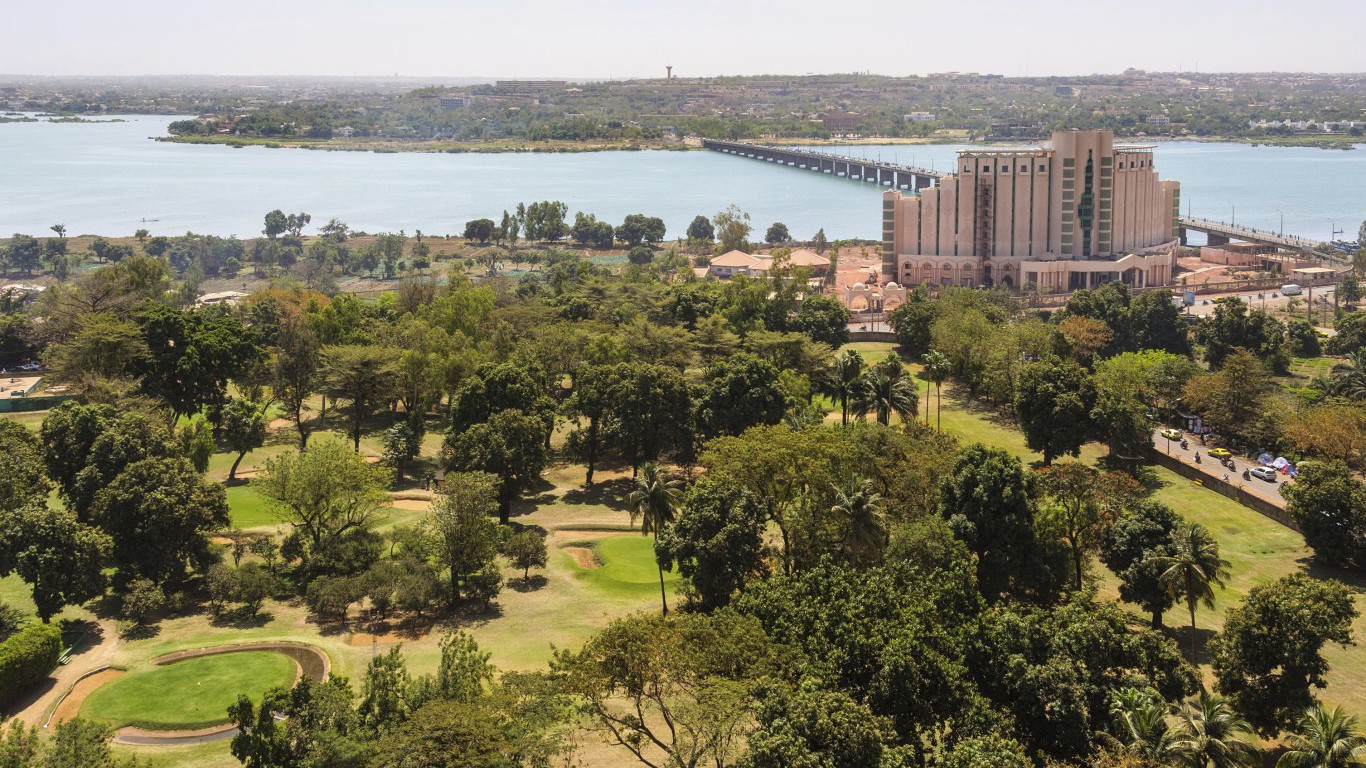
21. Mali
> GNI per capita: $2,218.36
> 2015 GDP: $35.70 billion
> Population: 17,599,694
> Life expectancy: 58.0 years at birth
Economic development in Mali, one of the world’s poorest countries, has been stymied by conflict and political upheaval. In recent years, armed conflicts have erupted in the region, further destabilizing parts of Mali.
Mali is one of Africa’s largest producers of cotton, which accounts for more than half of the country’s total exports. To protect its primary industry, Mali has advocated against subsidies cotton farmers in wealthier countries such as the United States receive. Mali also relies heavily on foreign aid. An estimated 2.5 million Malians are currently dependent on humanitarian aid in the northern part of the country. Mali also struggles with infrastructure problems and access to basic health care. Only about a quarter of Mali’s population has access to electricity, and only one in every 10 women aged 15 to 49 years have access to modern contraceptive methods.

20. Chad
> GNI per capita: $1,990.87
> 2015 GDP: $30.53 billion
> Population: 14,037,472
> Life expectancy: 51.6 years at birth
Chad reported an 8.1% deflation rate last year, one of the largest in the world. Deflation generally increases unemployment and further strains a country’s economy. For Chad, one of the world’s poorest countries with a GNI per capita of $1,991, such high deflation may not bode well. Already, according to estimates from the African Development Bank, GDP growth has slowed to 2.6% this year from 4.1% in 2015.
[in-text-ad]
High incomes typically help increase access to and quality of medical care, leading to better health outcomes. One of the poorest countries in the world, Chad also has one of the lowest life expectancies. At birth, a resident of the Central African nation is expected to live only 51.6 years on average, shorter than in all but one other country examined.
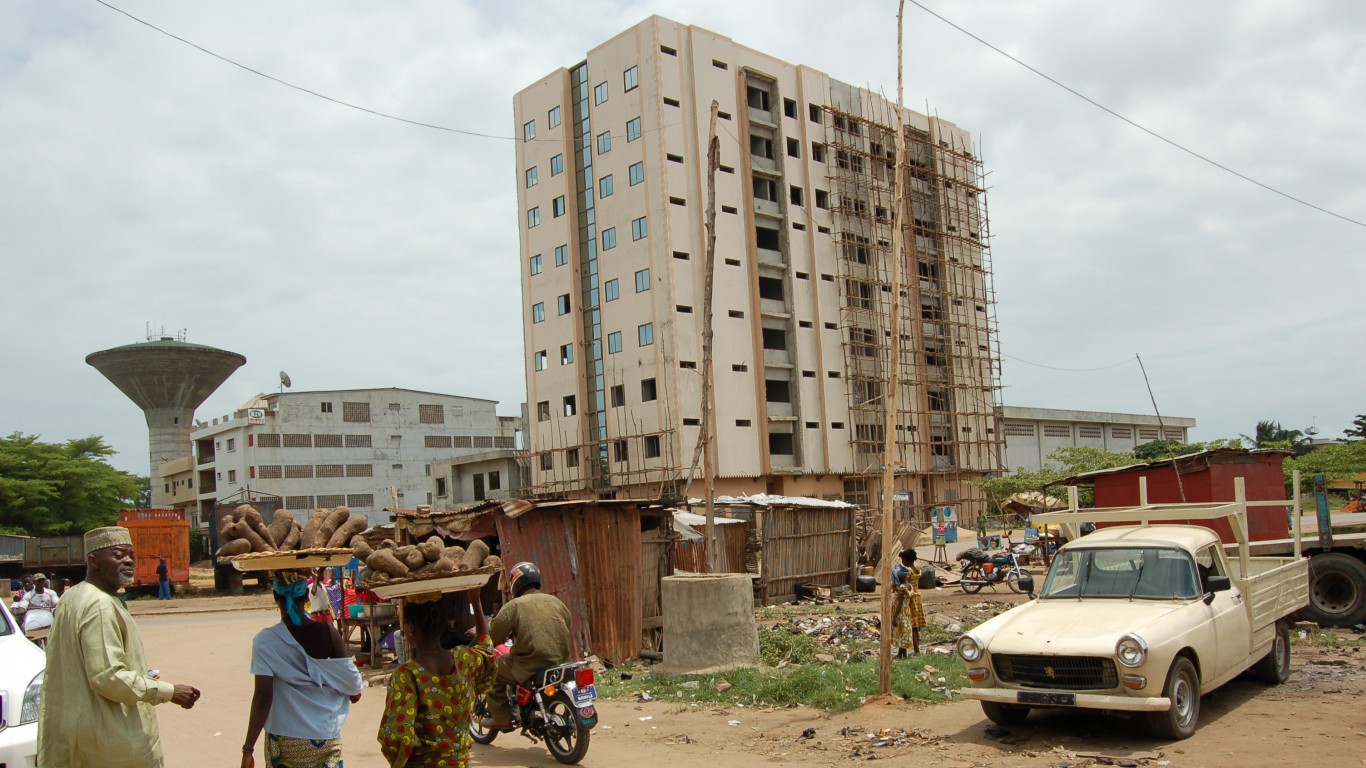
19. Benin
> GNI per capita: $1,979.25
> 2015 GDP: $22.94 billion
> Population: 10,879,829
> Life expectancy: 59.5 years at birth
GNI per capita in the West African nation of Benin is only $1,979. The country shares many characterics with other poor countries. More than half of Benin’s population lives in rural areas, and only 38% of the country’s adults are literate.
Due to flooding and the global financial crisis, economic growth in Benin was particularly poor in 2009 and 2010. Over the following half decade, the government implemented its Growth and Poverty Reduction Strategy. While the long-term benefits of the government program remain to be seen, Benin reported relatively strong 5.0% economic growth in 2015.
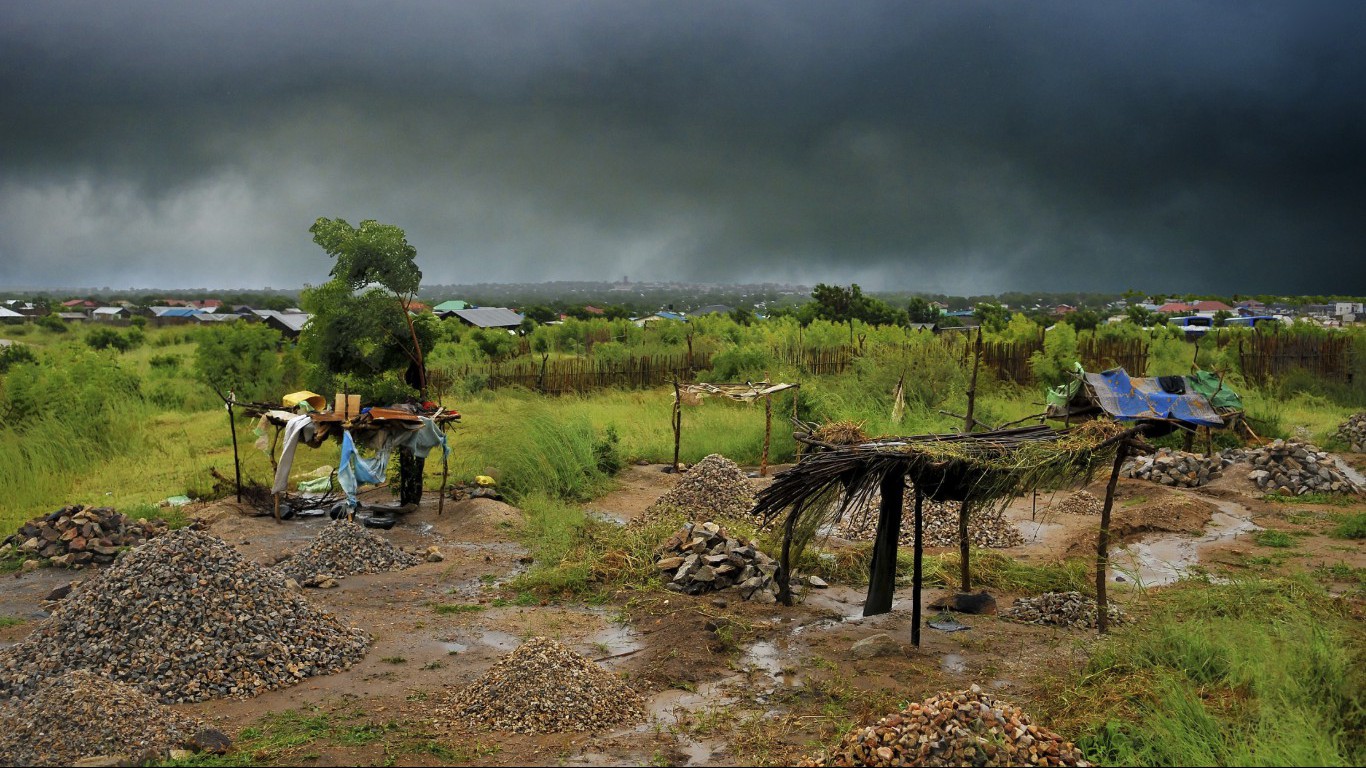
18. South Sudan
> GNI per capita: $1,882.50
> 2015 GDP: $23.73 billion
> Population: 12,339,812
> Life expectancy: 55.7 years at birth
Poverty and conditions that lead to weak economies tend to result in shorter lifespans. Someone born in South Sudan can expect to live to just 55.7 years, about 23 fewer years than a person born in the United States. As is the case in many extremely impoverished nations around the world, most South Sudanese lack access to many of the amenities Americans may take for granted. While effectively all Americans have access to electricity, just 5.1% of people in South Sudan do.
The country became an independent nation in 2011, separating from Sudan. Even after becoming independent, the country continued to be ravaged by conflict. A civil war from 2013 to 2015 displaced more than 2 million South Sudanese, about one in every six people in the country.

17. Uganda
> GNI per capita: $1,670.19
> 2015 GDP: $79.88 billion
> Population: 39,032,383
> Life expectancy: 58.5 years at birth
Roughly 72% of workers in Uganda earn a living through farming. Of those Ugandan workers not employed in agriculture, nearly 94% earn a living in the informal sector, which is not tracked or taxed by the government. Lacking a diverse and robust job market, per capita income is only $1,670 in Uganda.
Conditions in the East African nation may gradually improve in the coming years. Uganda received $1.3 billion in foreign investment in 2015. Experts anticipate the country’s oil sector to continue to attract significant foreign investment. The country’s economy expanded by 4.8% in 2015, and growth is projected to reach 5.1% in 2016 and 5.8% in 2017.

16. Haiti
> GNI per capita: $1,656.94
> 2015 GDP: $18.82 billion
> Population: 10,711,067
> Life expectancy: 62.7 years at birth
As is the case in a number of the world’s poorest nations, low incomes in Haiti are likely among the least of the problems facing people in the devastated country. Hurricane Matthew, which struck Haiti this October, wiped out bridges, roads, schools, and thousands of homes. According to newspaper Haiti Libre, 14,530 people were displaced. The devastation from the category 4 hurricane, combined with the cholera outbreak introduced by international aid workers in the aftermath of the 2010 earthquake — yet another disaster that left hundreds of thousands dead or displaced — means Haitians will likely remain among the poorest people in the world. The official poverty rate in Haiti of 58.5%, while among the highest of any country, may even be an underestimation.

15. Rwanda
> GNI per capita: $1,616.86
> 2015 GDP: $20.46 billion
> Population: 11,609,666
> Life expectancy: 64.0 years at birth
Many of the world’s poorest nations have experienced extremely violent conflict in their recent past that left the regional economy devastated. This is certainly the case with Rwanda, which infamously was the site of brutal government-sponsored genocide in the mid 1990s that left at least 800,000 Tutsis dead. The country’s people and economy are still struggling to recover from the period of ethnic cleansing.
[in-text-ad]
Poorer, less diverse economies tend to have a disproportionately large segment of workers employed as farmers rather than in the service sector or industrial production. In the United States, less than 2% of the total workforce consists of hired farmhands. In Rwanda, 75.3% of all workers are employed in agriculture, tied with Madagascar as the largest share of any country in the world with available data.

14. Zimbabwe
> GNI per capita: $1,587.72
> 2015 GDP: $28.04 billion
> Population: 15,602,751
> Life expectancy: 57.5 years at birth
In 2009, Zimbabwe went through a period of hyperinflation that nearly destroyed the economy. At one point, one U.S. dollar was worth 35 quadrillion (35 thousand trillion) units of the local currency. The country is currently phasing out its own currency, and residents now use several other major currencies, including the U.S. dollar.
Seven years after the period of hyperinflation, Zimbabwe’s economy remains quite weak. The South African nation’s GDP grew by just 1.1% last year, compared to a U.S. growth rate of 2.6%. The country’s GNI is just $1,588 per capita, one of the lowest in the world.
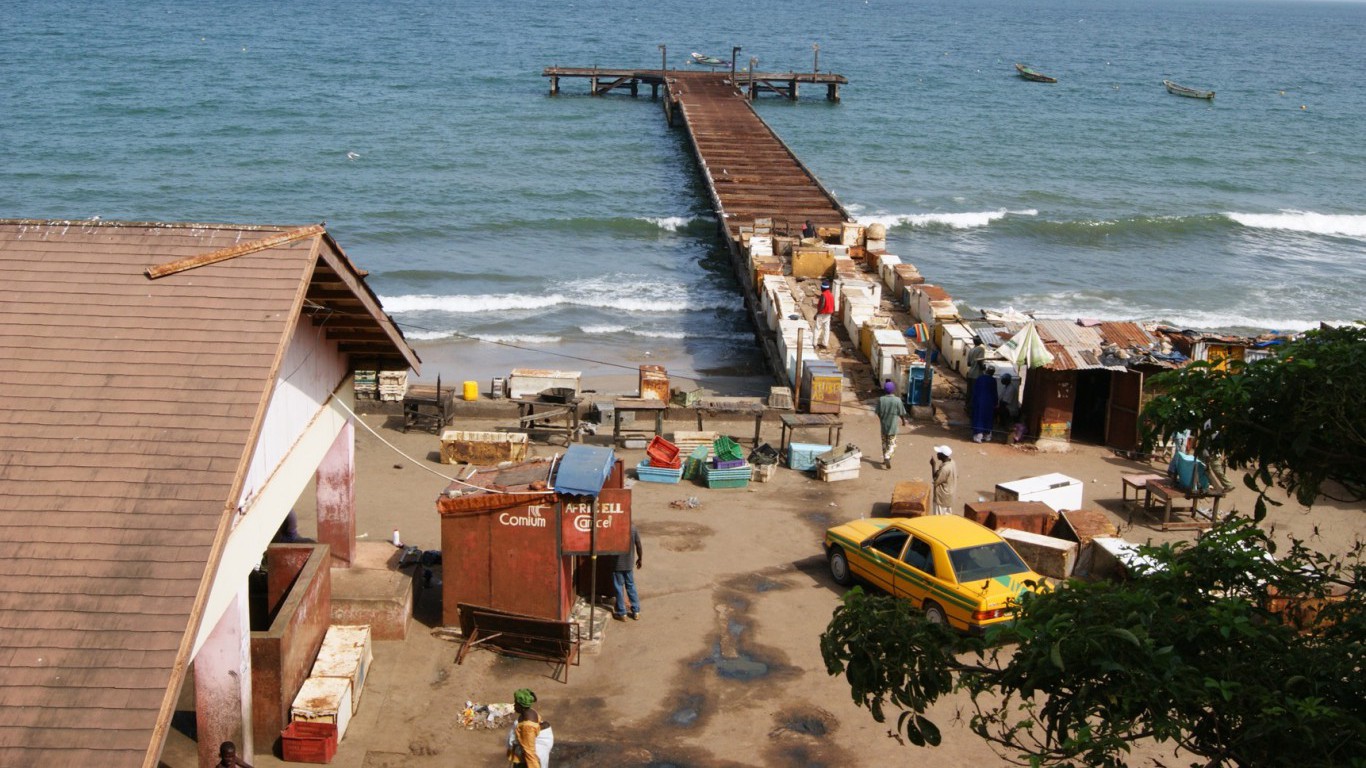
13. The Gambia
> GNI per capita: $1,553.19
> 2015 GDP: $3.27 billion
> Population: 1,990,924
> Life expectancy: 60.2 years at birth
GNI per capita in The Gambia is only $1,553, nearly the lowest in the world. The country faces considerable hurdles to economic development. More than 40% of adults in the country are illiterate, and only 17% of the country’s population uses the internet. The country’s infrastructure is limited in other ways as well — nearly two thirds of Gambia residents do not have access to electricity.
Stymied by its proximity to the ebola outbreak in nearby Guinea, Sierra Leone, and Liberia, and the resulting decline in tourism, Gambia’s economy expanded by only 0.9% in 2014. Growth has improved since. Gambia’s GDP growth rate was 4.4% last year and could foreseeably exceed 5% in 2016 on the back of growth in the tourism and agriculture industries.
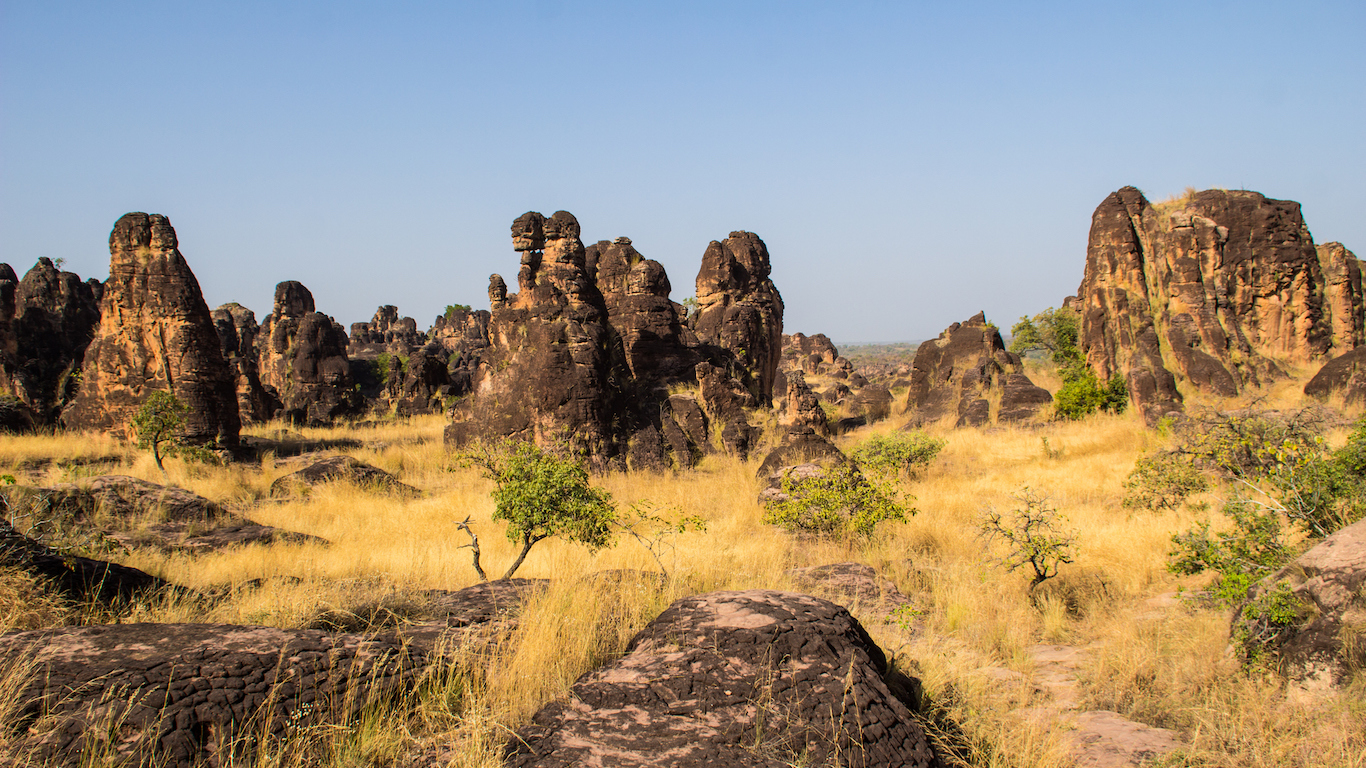
12. Burkina Faso
> GNI per capita: $1,537.50
> 2015 GDP: $30.95 billion
> Population: 18,105,570
> Life expectancy: 58.6 years at birth
One of the poorest countries in the world, Burkina Faso’s economy is largely driven by mining and agriculture, making it vulnerable to fluctuations in global commodities markets. Indeed, declines in the price of gold and cotton are primarily behind the country’s only modest economic growth in 2015.
Burkina Faso exhibits many features common in poor African nations. One of the least urbanized countries in the world, more than 70% of the population lives in rural areas, and only 13% have access to electricity. Additionally, fewer than 40% of adults in the country are literate, and Burkina Faso is one of only 18 countries where life expectancy at birth is below 60 years.
Economic growth in the country is almost certainly further hindered by widespread crime. According to a Pew study, more than eight in 10 Burkina Faso residents agree that crime is a very big problem.
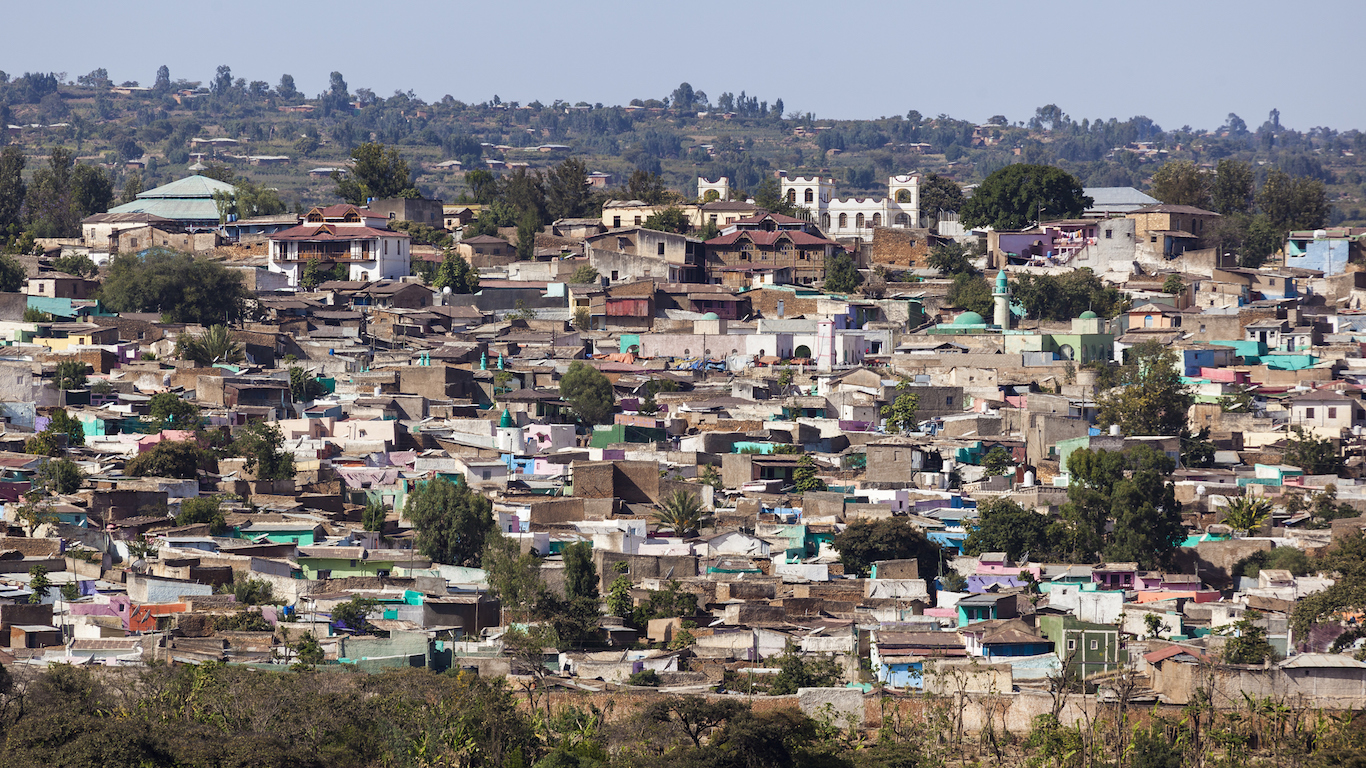
11. Ethiopia
> GNI per capita: $1,522.95
> 2015 GDP: $161.96 billion
> Population: 99,390,750
> Life expectancy: 64.0 years at birth
With nearly 100 million residents, Ethiopia is the second most populous country in Africa behind Nigeria, and one of the most populous in the world. While Ethiopia has taken some steps to modernize its economy, the East African nation continues to have one of the poorest and least diverse economies in the world, particularly for a nation of its size. Less than half of the country’s adult population is literate. Countries with less developed economies often rely on subsistence farming. More than 70% of the country’s workers are employed in agriculture, a larger share than in nearly any country. In contrast, hired farmworkers make up less than 2% of total U.S. workers.
However, Ethiopia’s economy appears to be growing rapidly. The country’s GDP growth rate of 10.2% last year was the largest economic growth of any country in the world with the exception of Ireland.
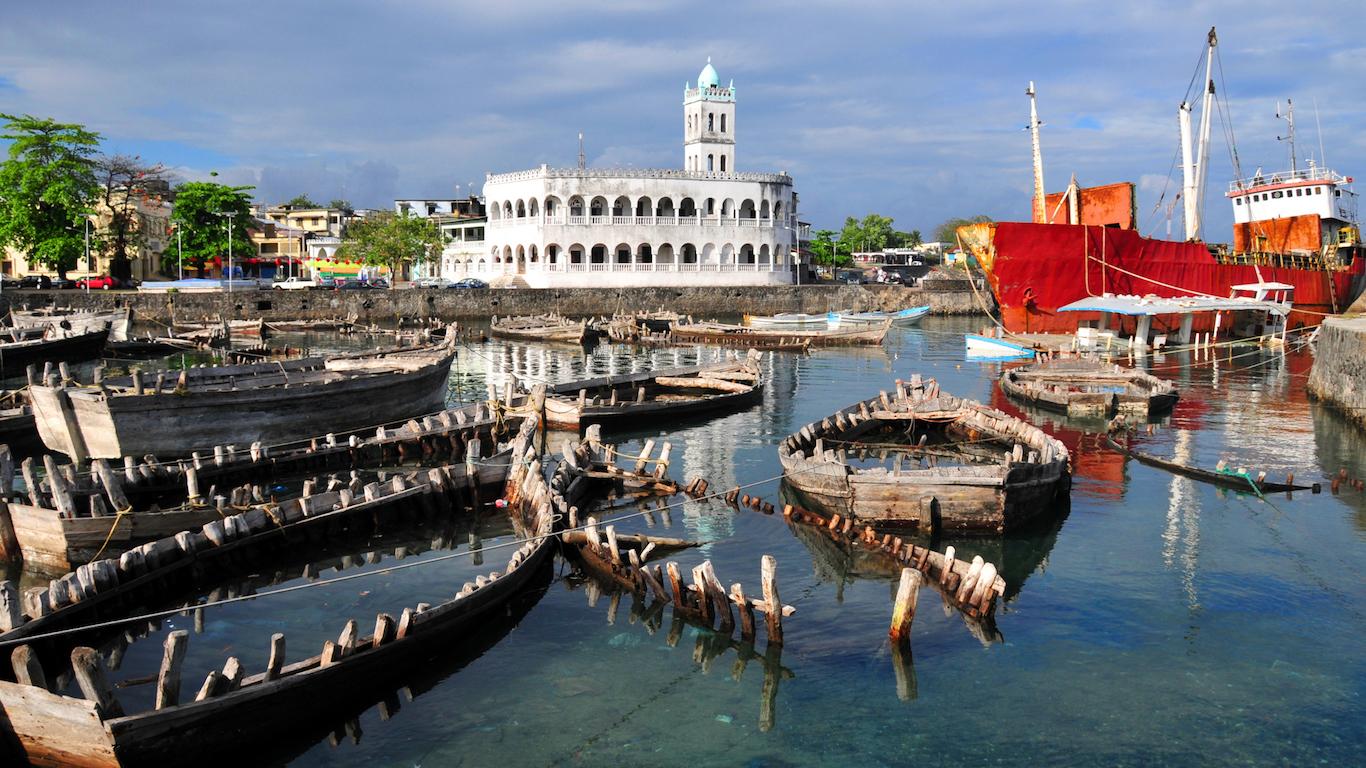
10. Comoros
> GNI per capita: $1,360.98
> 2015 GDP: $1.22 billion
> Population: 788,474
> Life expectancy: 63.3 years at birth
Political turmoil and deficiencies in infrastructure are hindering economic growth in Comoros. The small African island nation in the Indian Ocean has undergone more than 20 coups or attempted coups since 1974. A former French colony, many educated and skilled workers have left Comoros for France.
[in-text-ad]
With miles of beautiful beaches, the country’s tourism industry has considerable potential. Upcoming infrastructure improvements may help tremendously. Recently, both China and Saudi Arabia have provided significant budget support to Comoros to address its energy woes.
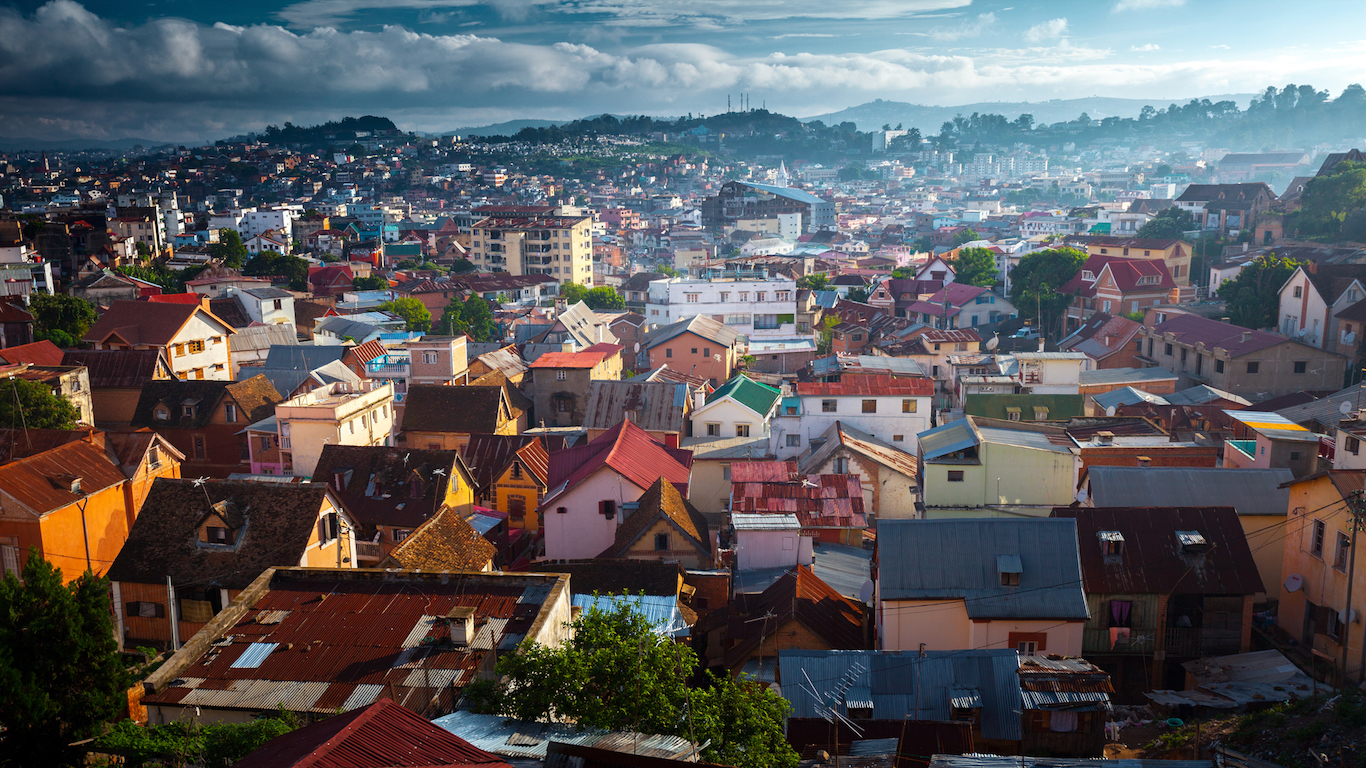
9. Madagascar
> GNI per capita: $1,319.70
> 2015 GDP: $35.53 billion
> Population: 24,235,390
> Life expectancy: 65.1 years at birth
As an island nation off the eastern coast of Africa, Madagascar is geographically removed from much of the cross-border violence that has afflicted the continent over the years. That has not, however, kept the nation of 24 million from struggling with conflict. There have been several coups and violent uprisings in the country.
The country’s isolation has also not kept it out of poverty. Madagascar has a GNI of $1,320 per capita, approximately 2.5% of the U.S. GNI per capita. The country has considerable natural resources, and its diverse wildlife has created a substantial tourism industry, but the economy is still quite underdeveloped. Madagascar is one of the largest recipients of international aid of any country in the world. As of last year, nearly 2 million Madagascar residents did not have access to a secure source of food.

8. Togo
> GNI per capita: $1,262.17
> 2015 GDP: $10.88 billion
> Population: 7,304,578
> Life expectancy: 59.7 years at birth
Agricultural output accounts for 41% of Togo’s total GDP, the third largest such share in the world. Like many economies overly dependent on agriculture, Togo is extremely poor and underprepared for economic expansion. GNI per capita is only $1,262 in the Sub-Saharan African nation, and roughly a third of the adult population is illiterate.
Urbanization and investment in infrastructure can be critical to economic development. Though still 60% rural, Togo has become markedly more urban in recent years. The number of people living in cities increased by 160% between 1990 and 2014. Experts predict that half of the country will live in urban centers by 2030. Additionally, the government has invested heavily in infrastructure each year since 2010.

7. Mozambique
> GNI per capita: $1,098.44
> 2015 GDP: $33.35 billion
> Population: 27,977,863
> Life expectancy: 55.0 years at birth
One of the poorest countries in the world, Mozambique also has one of the lowest life expectancies. The average life expectancy at birth in the East African nation is only 55 years, nearly four years shy of the average across Sub-Saharan Africa, which itself has one of the lowest average expectancies of any region.
Though poor, current economic conditions in the country are actually an improvement over previous years. Over the 10 years ending with 2014, Mozambique’s GDP grew at a pace of at least 7% a year. Economic expansion slowed in 2015 but remained relatively robust at 6.6%. Still, according to the United Nations, there are significant disparities across the country. Many of the 80% of residents without electricity likely live in underdeveloped rural areas.
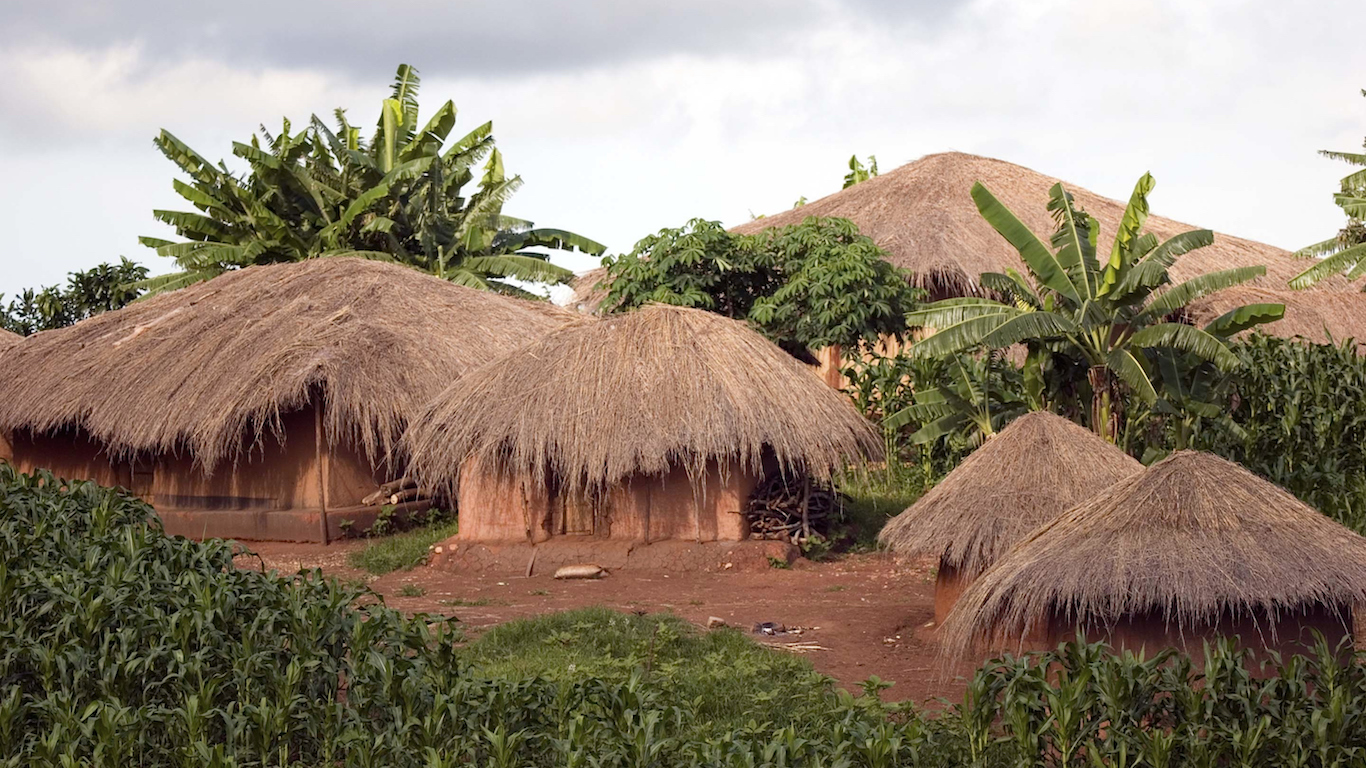
6. Malawi
> GNI per capita: $1,073.29
> 2015 GDP: $20.40 billion
> Population: 17,215,232
> Life expectancy: 62.7 years at birth
Like many of the poorest countries in the world, Malawi’s economy is disproportionately dependent on agriculture, a large share of which is subsistence farming. Agriculture accounts for about 30% of Malawi’s GDP. In contrast, just 1.3% of the U.S. economy is agriculture based.
As often accompanies poor, less diverse economies, Malawi residents appear to have a relatively poor quality of life. Life expectancy at birth is 62.7 years, about 16 years less than the average life expectancy in the United States. This is likely due in part to the fact that Malawi was one of the nations hit hardest by HIV/AIDS. Almost 1 million of the country’s 17.2 million people live with the illness.

5. Guinea
> GNI per capita: $1,058.22
> 2015 GDP: $15.29 billion
> Population: 12,608,590
> Life expectancy: 58.7 years at birth
The West African nation of Guinea is one of the five poorest in the world, with a GNI of just $1,058 per capita.
[in-text-ad]
Residents of extremely low-income countries tend to have worse health outcomes and a lower quality of life. Someone born in Guinea today is expected to live to an average of just 58.7 years, more than two full decades less than the average American. One factor likely contributing to these extremely low life expectancies is the prevalence of HIV/AIDS in the country. There are at least 120,000 Guinea residents living with HIV. That rate may be higher than reported, as just 5.6% of women report using contraception of any kind during sexual activity.

4. Niger
> GNI per capita: $889.46
> 2015 GDP: $19.01 billion
> Population: 19,899,120
> Life expectancy: 61.5 years at birth
In nearly all countries, the working age population — adults between 15 to 65 years old — is larger than the dependent population — those too young or too old to work-optional. Niger is one of just four nations in which the working-age population is smaller than those younger than 15 years and older than 65. Such a situation further strains a country’s resources and economy. In Niger’s case — already one of the poorest countries — it adds to residents’ struggles.
Niger gained its independence from the French in the 1960s and has struggled to modernize and develop a diverse economy. To date, less than one in five adults in the country are literate, and agriculture accounts for more than one-third of the country’s economic output, among the most of any nation.
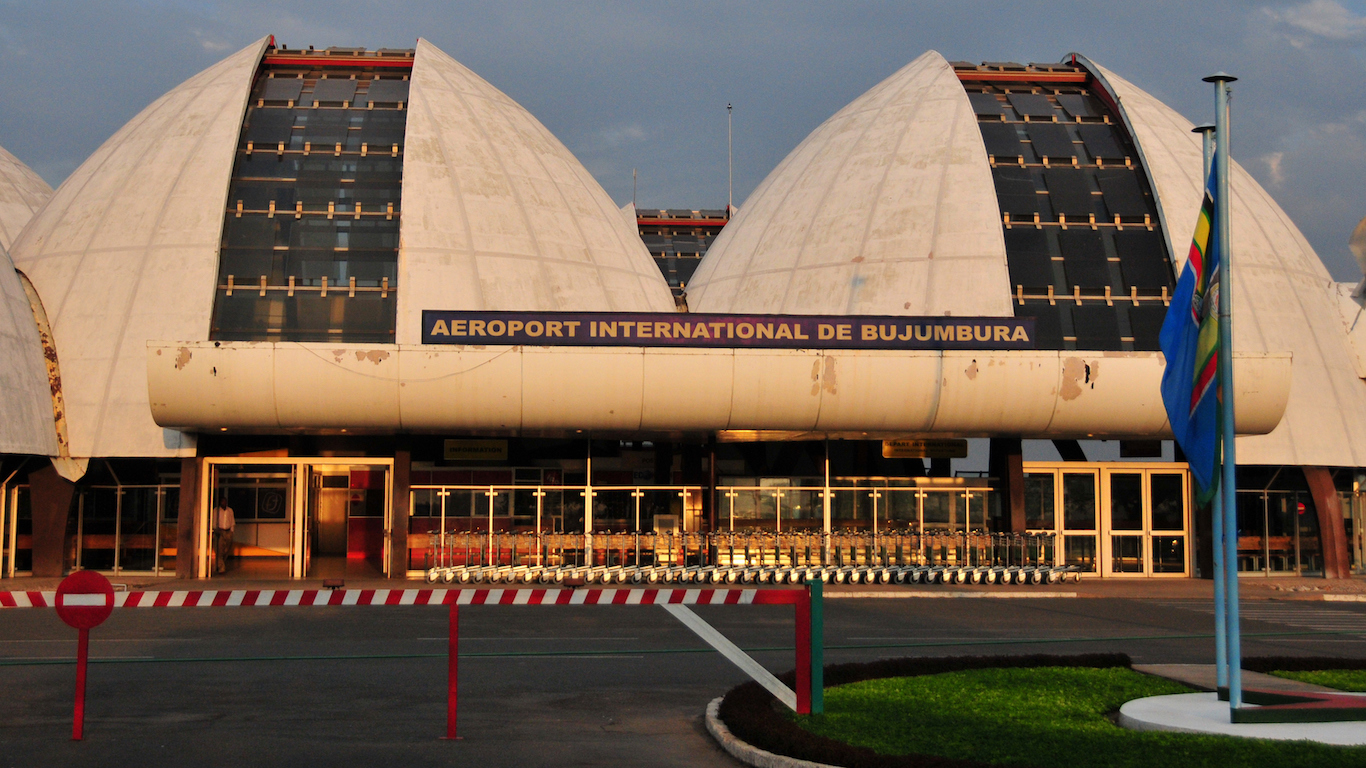
3. Burundi
> GNI per capita: $691.18
> 2015 GDP: $7.83 billion
> Population: 11,178,921
> Life expectancy: 56.7 years at birth
Beginning in the early 1990s, Burundi was embroiled in an ethnic civil war that lasted until 2006 and decimated the economy. The ensuing peace resulted in some economic stabilization. However, a recent election has sparked renewed violence. The country’s economy has since lost much of the ground it gained, entering a deep recession.
Burundi’s GDP shrank by 4% in 2015, among the worst economic contractions of any nation. While government poverty statistics are not always reliable, an estimated 65% of the nation’s population lives in poverty.
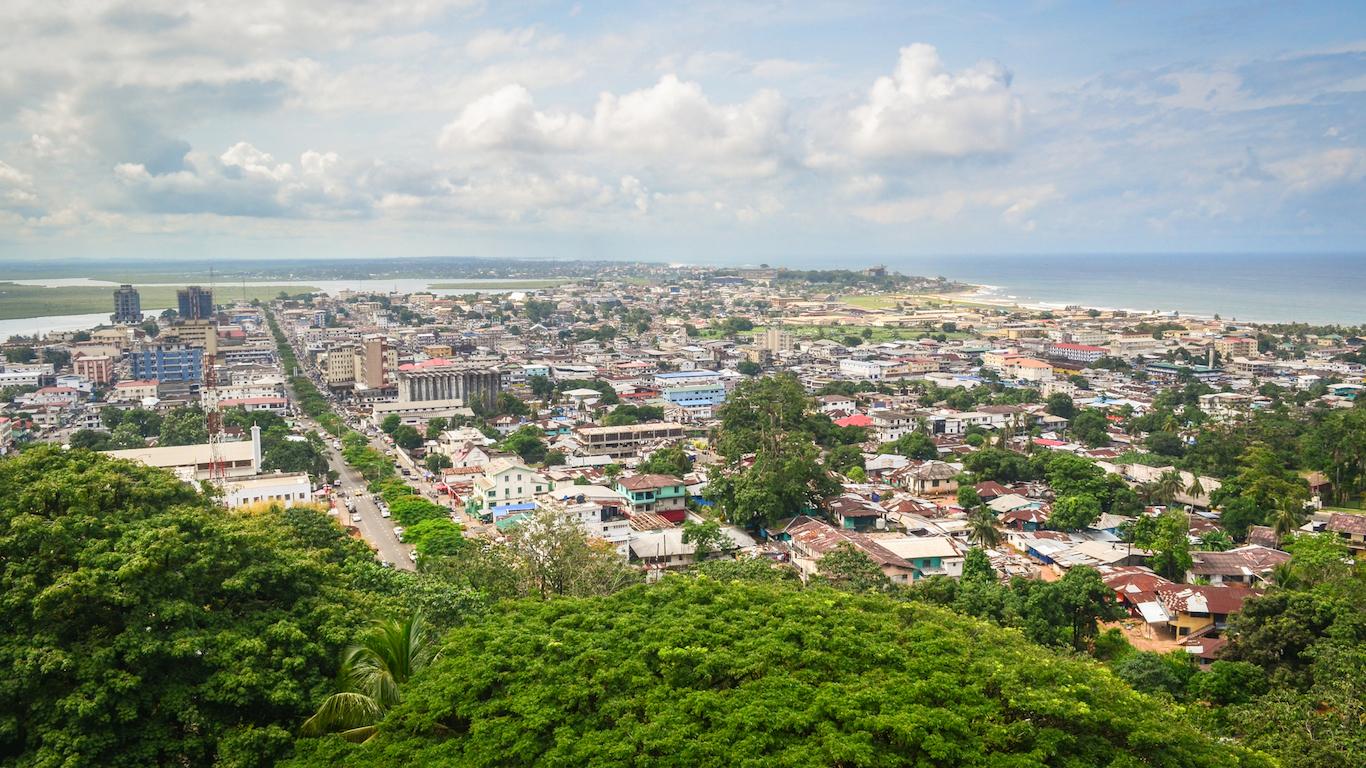
2. Liberia
> GNI per capita: $682.59
> 2015 GDP: $3.76 billion
> Population: 4,503,438
> Life expectancy: 60.8 years at birth
Nearly the poorest country in the world, less than 10% of Liberia’s population has access to electricity, and fewer than half of all adults in the country are literate.
Like many other poor African nations, economic prosperity in Liberia has been hindered by violence. Between 1989 and 2003, a brutal civil war claimed the lives of an estimated quarter million Liberians. More recently, the country was among the hardest hit by the West African Ebola outbreak, which effectively brought the country’s economy to a grinding halt. Currently, falling prices of iron ore and rubber, two of Liberia’s chief exports, are slowing economic growth considerably.
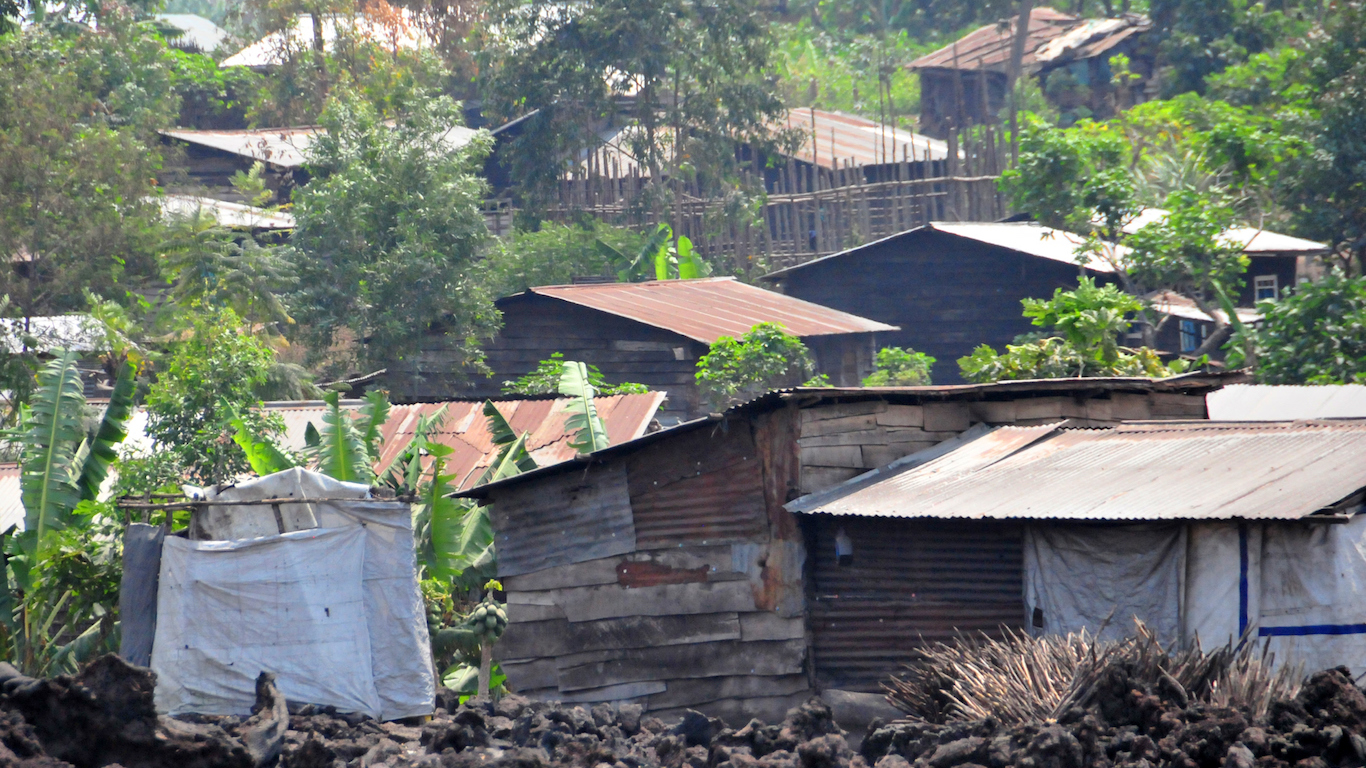
1. Congo, Dem. Rep.
> GNI per capita: $679.63
> 2015 GDP: $62.69 billion
> Population: 77,266,814
> Life expectancy: 58.7 years at birth
Abundant natural resources, while the basis of wealth in many nations, are no guarantee of financial prosperity. The resource-rich Democratic Republic of the Congo, with a GNI per capita of $680 — the lowest in the world — is a case in point. The DRC, one of the largest countries in Africa, is home to large deposits of copper, gold, diamonds, cobalt, uranium, coltan, and oil. Government corruption, demanding corporate interests from abroad, and seemingly endless war have largely prevented the DRC from capitalizing on its natural wealth.
People living in the DRC have struggled with violence and political corruption for hundreds of years. The country’s resources were being exploited by foreigners as early as the 1880s, when Belgium’s King Leopold II, who may have killed millions of people in the region, profited immensely from rubber and ivory.
The thought of burdening your family with a financial disaster is most Americans’ nightmare. However, recent studies show that over 100 million Americans still don’t have proper life insurance in the event they pass away.
Life insurance can bring peace of mind – ensuring your loved ones are safeguarded against unforeseen expenses and debts. With premiums often lower than expected and a variety of plans tailored to different life stages and health conditions, securing a policy is more accessible than ever.
A quick, no-obligation quote can provide valuable insight into what’s available and what might best suit your family’s needs. Life insurance is a simple step you can take today to help secure peace of mind for your loved ones tomorrow.
Click here to learn how to get a quote in just a few minutes.
Thank you for reading! Have some feedback for us?
Contact the 24/7 Wall St. editorial team.